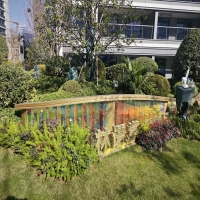Welcome to the website for landscape facilities products and knowledge.
What are the environmental impacts of the materials used in the Landscape Round Table?
Landscape round tables serve as central gathering points in outdoor spaces, yet their material composition carries significant environmental implications. The selection of materials—ranging from tropical hardwoods to recycled plastics—directly influences ecological footprints through resource extraction, manufacturing processes, and end-of-life disposal.
Natural wood options, particularly teak or redwood, often involve deforestation concerns unless certified by sustainable forestry programs. These materials may require chemical treatments against weathering, potentially leaching toxins into soil and water systems. Alternatively, responsibly harvested cedar or bamboo offer renewable alternatives with faster growth cycles and lower processing impacts.
Composite materials present another dimension of environmental consideration. While recycled plastic lumber diverts waste from landfills and resists rotting, its production relies on energy-intensive recycling facilities and fossil fuel derivatives. Powder-coated aluminum tables provide durability but entail high carbon emissions during smelting processes, though recycled aluminum options significantly reduce this footprint.
Concrete tables, valued for their permanence, carry substantial embodied carbon from cement production—a notable contributor to global CO2 emissions. Innovations in geopolymer concrete are emerging as lower-carbon alternatives. Natural stone tables involve quarrying impacts but offer exceptional longevity, reducing replacement frequency.
The lifecycle assessment of these materials reveals critical trade-offs between durability, maintenance requirements, and ecological consequences. Sustainable choices often balance local material sourcing to minimize transportation emissions with designs that facilitate eventual disassembly and recycling. As landscape architecture evolves, manufacturers are increasingly incorporating cradle-to-cradle principles, using non-toxic finishes and designing for circular economy integration.
Ultimately, informed material selection for landscape round tables involves evaluating entire supply chains—from raw material sourcing through manufacturing to long-term maintenance needs. Environmentally conscious specifications now prioritize FSC-certified woods, high-recycled content composites, and locally quarried stone to minimize ecological disruption while creating functional, enduring outdoor furnishings.
Related search:

Recommendation
Metal and acrylic color-changing combined curtain wall for large-scale public landscape facilities